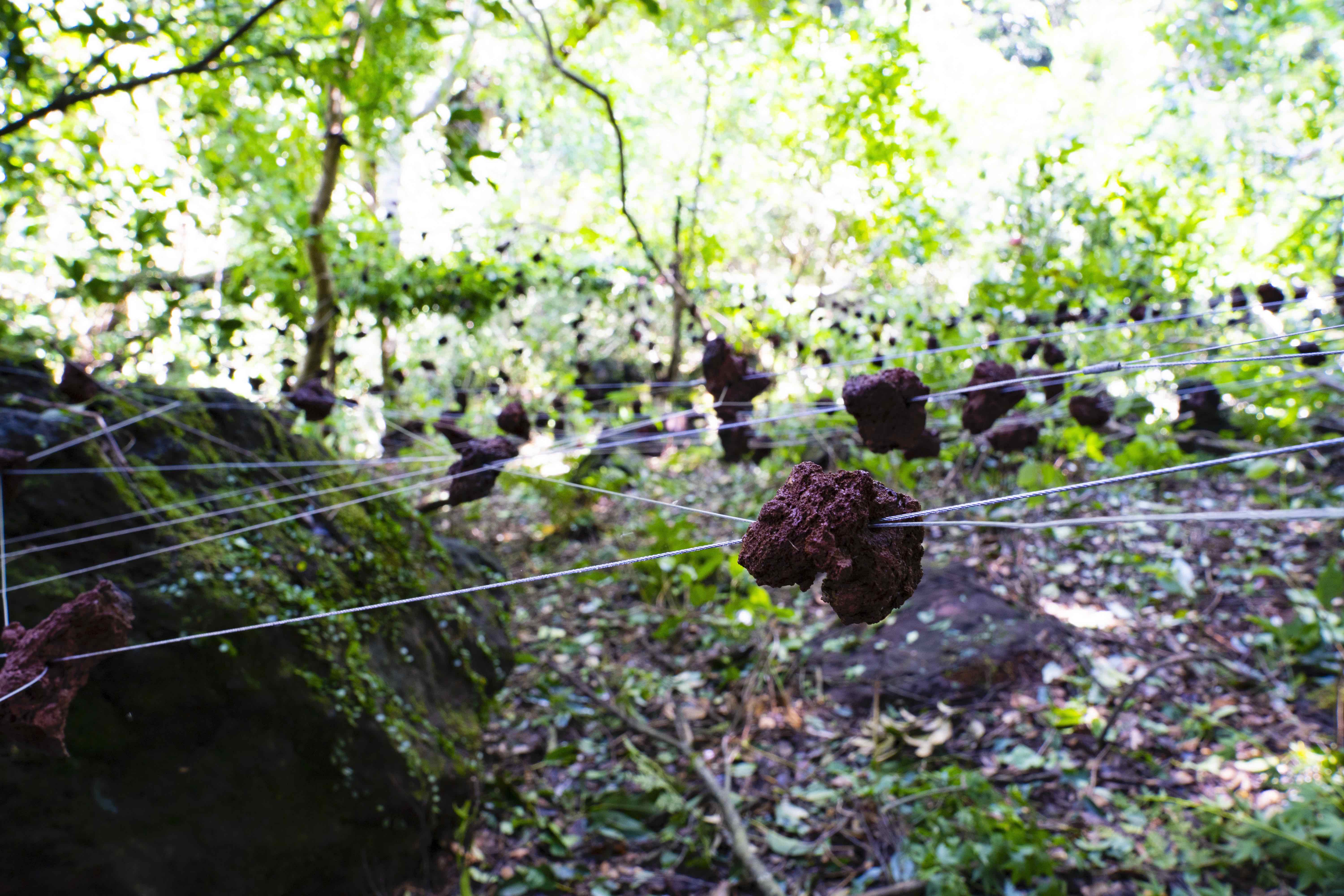Critic
비평 Critic
<제주 화산섬과 용암동굴> 세번째 이야기: 거문오름과 화산송이
우리가 전시를 한 장소 중의 한 곳이 거문오름이라고 불리는 분석구(송이오름)이다. 화산분출로 이루어진 오름은 제주에 전부 368개가 있다고 하는데, 사실상 오름 자체가 화산분출로 만들어진 화산에 대한 제주 방언이다. 그렇다면 제주라는 화산섬은 이 작은 화산체들로 이루어진 화산섬이라는 말이 맞을 것이다. 어떤 이는 오름은 단어 오르다의 명사형인 오름과 몽골어로 산 꼭대기를 뜻하는 oroi의 발음이 전이되어서 오름이라고 부른다고 하지만, 엄밀히 말하자면 화산폭발로 형성된 산이 오름이라고 정의 될 수 있다. 한라산은 그런데 왜 오름이 아닐까? 그것은 한라산이 화산의 주체이기에 오름이 아니라고 말할 수 있다. 즉 화산의 곁에서 생겨난 기생화산만이 오름에 해당되는 것이다. 제주도 오름 중 유일하게 세계자연유산으로 지정된 거문오름은 단성화산체(특정기간에만 분출해서 쌓인 물질로 이루어진 화산으로서 그 기간 이후 다시 분출하지 않음)로서 울창한 숲이 검게 보여서 '신령스러운 공간'이란 의미를 갖는다.
거문오름의 꽃은 단연 화산송이가 아닐까? 거문오름이 형성될 때 폭발적인 화산분출은 많은 양의 화산분쇄물을 갖게 되는데, 거문오름엔 유독 붉은색 스코리아(화산송이: 제주사투리)가 많다. 땅 밑 지하 수 킬로미터 안에 암석이 녹아 만들어진 뜨거운 마그마가 괴어 있다가 마그마의 압력이 높아지면 그 안에 있는 수증기나 휘발성가스(이산화탄소 및 기타 가스)가 엄청난 힘으로 빠져나와 마그마를 갈기갈기 쪼개 작은 마그마 알갱이를 만들면서 분출한다. 이 분출물 중에서 화산가스와 수증기가 제거된 마그마파편들 중에 검은색 스코리이(검은색 송이)가 있고 붉은색 스코리아(붉은색 송이) 혹은 암갈색 스코리아(암갈색 송이)가 있다. 증기에 산화된 마그마는 붉은 송이이고, 열기에 노출이 안된 마그마는 검은 색 송이라고 한다. 거문오름에는 유독 아름다운 붉은 빛의 다공질 화산송이가 많다.
거문오름의 초중반쯤에 이르면, 와이어로 카펫처럼 짜여져 공중부양한 작품이 있다. 바로 김순임의 <흐르는 돌>이라는 작품! 작가는 평소에도 '굴러가는 돌'에 관심이 많았다는데... 흔한듯 흔하지 않은 돌멩이에 눈길이 가던 작가에게 이 거문오름의 곳곳에 피어난 붉은 송이들은 당연히 눈과 마음의 시선이 작동했을 것이다. 거문오름의 분화구에서 용암길의 궤적을 따라 답사길을 걸을때부터 이 돌들은 어디에서 왔고, 언제 불에서 돌로 흘러온 것일까 하는 작가의 물음은 천개가 넘는 화산송이를 산으로 가져와 와이어에 엮는 엄청난 노동의 작업을 탄생시켰다. 태풍과 폭염 사이를 오가며 거의 열흘이 넘게 매달려 완성시킨 이 돌 카펫트 작업 위에 어느날 태풍에 쓰러진 나무가 덮쳤으나, 오름을 지키는 마을 이장님(현재 자연해설사 단장)과 동료 작가들의 도움으로 간신히 복구를 했다. 지금은 우리가 걸으며 통과할 수 있는 키 높이에 매달려 있는데, 위에서 아래로 흐르는 듯 경사지게 설치되어 있어서 실제로 한 눈에 다 들어오지는 않는다. 그러나 우리가 불길이 지나간 협곡 곁에서 감상하노라면 '흐르는 불/돌'의 물결이 오감으로 느껴지는 것이다.

Review
The Third Story of Volcanic Jeju Island and Its Lava Tubes: Geomunoreum and Scoria, directed by Hyunju Yu (director, 2020 World Heritage Festival)
One of the exhibition sites is a scoria cone (Songioreum). It is said that as many as 368 oreums (parasitic cones) have been created by volcanic eruptions on Jeju Island. Oreum is a word in the Jeju dialect that refers to a volcanic mound resulting from a volcanic eruption. Therefore, Jeju can be regarded as a volcanic island consisting of abundant small volcanic edifices. Some say the origin of the word oreum comes from “climb,” and that its pronunciation is an evolution of oroi, or “mountain top” in Mongolian language. However, strictly speaking, oreum can be defined as a mountain created after a volcanic eruption. In that case, why is Mount Hallasan not an oreum? The answer is that Mount Hallasan was the principal agent of a volcano. In other words, only parasitic cones fall under this category. Geomunoreum, the only oreum on Jeju Island that has been designated a UNESCO Natural World Heritage site, is a monogenetic volcano (single-eruption volcano consisting of substances that erupted and gathered for a certain period) and implies a ‘divine space’ because of the black appearance of its surrounding thick forest.
Geomunoreum’s flower must be scoria. When Geomunoreum was created, the explosive eruption yielded several volcanic products. Geomunoreum has exceptional amounts of red scoria (known as hwasansong-i in Jeju dialect). Hot magma created from molten rock gathered a couple of kilometers underground, and when the pressure of this magma increased, steam or volatile gases (carbon dioxide and others) inside were expelled with immense force. At that point, the magma split into several pieces and erupted by making smaller ones. These magma fragments, with volcanic particles and steam removed, consist of black, red, and dark brown scoria. Oxidized magma is red scoria, and magma that has not been exposed to heat is black scoria. Geomunoreum is notable for its beautiful, porous, red scoria.
Within the lower and middle zones of Geomunoreum, an installation woven with wires like a carpet appears to float in the sky. This is Flowing Stones by Kim Soonim, an artist who is interested in ‘rolling stones.’ To someone fascinated by common yet unfamiliar stones, the blooming red scoria of Geomunoreum must have captivated Kim's thoughts and gaze. While walking along the craters, the artist raised questions about where these stones originated and how they changed from fire to stone; such questions inspired her to transport more than a thousand scoria stones to the mountain, where she painstakingly wove them with wire through enormous effort. During a storm, a tree fell directly onto this stone carpet, which the artist had produced over the course of ten sweltering days, but thanks to the help of the village representative that protects oreums (present manager of the docents) and others, the project was eventually restored after much difficulty. It is installed on a slope and hung at a height that allows visitors to pass through, making it difficult to observe briefly. However, one can feel the waves of “flowing fire/stones” through all five senses when appreciating the work in close proximity to the very canyon where fire once flowed. (Via Facebook, by Hyunju Yu, September 17, 2020)